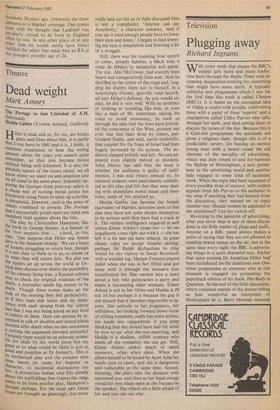Art
Plain precision
John McEwen
It is not exactly controversial of the Tate Gallery to mount a huge Landseer ex- hibition (till 12 April), but it is surprising enough to be significant. So why has Land- seer been privileged now after so many years of critical disapproval? Apart from a general swing to all things Victorian, the vulgar reason seems to be because it is in the American interest. The Americans have recently rediscovered their own 19th- century painters and the more securely they can tie them into western art history, the better they are pleased. A year or two back a large picture of icebergs by one of these artists, one Frederick E. Church (no right- thinking person had heard of him then; no right-thinking person has not heard of him now), made a world record price at auction. The present show was initiated by the Philadelphia Museum of Art, and it is sure- ly to align Landseer with Church that a most uncharacteristic painting of icebergs and polar bears has been selected for the catalogue cover. But of course other winds blow in Landseer's favour too. The art world is less stuffy about its likes and dislikes than it has been for a long time, and there are definite hungers to be satisfied: a hunger for depiction after so much abstrac- tion and theorising; and after so much im- precision and incompetence in painting, a hunger also for technical virtuosity. Land- seer satisfies both demands in full measure. Every picture tells a story, and in matters of technique he could not have been more of a perfectionist, designing his own brushes and, for his most lustrous paintings, prepar- ing gesso grounds of exquisite smoothness.
Textures, in fact, emerge as his forte. He positively empathises with the feel of things: scrubbing in fur effects, stroking on feathers, dragging his brush rough and dry for rocks. It is brilliant, but in the end it becomes too much of a demonstration, because put to such unvaried use. His ad- mirer Courbet was a master of textures too, but method with him was always at the ser- vice of emotion, and would be changed ac- cordingly. Landseer is one-track in com- parison, and shows a similar lack of im- agination in his compositions. Compared with the vigorous invention of the pose of `Fighting Dogs Getting Wind' at the outset of his career, most of what follows is dull and anti-climactic; a boredom enforced by
the repetition of the subject-matter not so much in the form of the dogs, as those endless piles of dead and bleeding deer and birds. His brilliance at fur and feathers con- demned him to be the chronicler of the Vic- torian passion for regulated blood sports; and he comes across as a victim, both of his facility and patrons. No wonder he suffered from sporadic and gathering depression and latterly took to the bottle. His most novel, and today most interesting, pictures seem to reflect his state of mind, being overtly sym- bolic variations on the theme of victims and victimisation — the polar bears (` Man Pro- poses, God Disposes'); eagles attacking a swannery; a cornered fox viewed, with rare originality, from above; a moonlit rutting scene Morning Events Cast their Shadow before Them'). For the rest, pathos balances bathos, and it is a lack of inven- tion rather than too much sentimentality that proves the rot of his achievement. The choice for the catalogue cover may accent these more overtly symbolic and psycho- logically revealing imaginings, but at the Tate there is no special pleading. In fact the only aspect of his output under-represented is precisely the one that a modern museum might have been expected to emphasise, namely the sketches, both in ink on paper and oil on board. This is a pity because they are among the freshest and certainly least dated of his works. There may be some ex- cuse in that Derek Hill concentrated on this aspect in his pioneer assessment at the Royal
Academy 20 years ago. Otherwise the show amounts to a blanket coverage. One comes away with the thought that Landseer was Peculiarly cursed to be born in England when he was. In any other place or at any other time he would surely have better fulfilled the talent that made him an RA at the youngest possible age of 24.





































 Previous page
Previous page